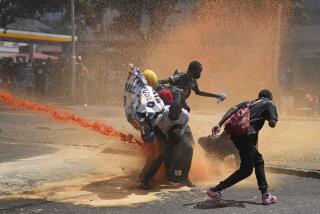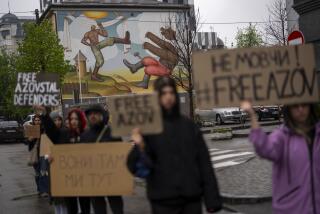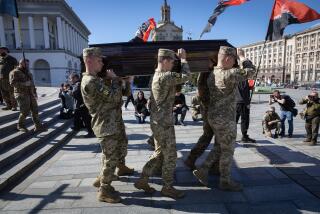Muscovites Take Ringside Seats at Parliament Battle : Crisis: Thousands risk their lives to watch. Some take sides but others are silent, aghast at what they see.
- Share via
MOSCOW — With every ear-shattering thud of a tank shell, Irina Vladimirovna Frolova’s heart skipped a beat.
The retired, white-haired sewing machine operator stood Monday afternoon on the opposite bank of the Moscow River from the Parliament, risking her life with thousands and thousands of fellow Russians to watch the battle unfolding before her eyes.
“I know it’s dangerous,” admitted the 58-year-old Muscovite, who, in a neat fur-trimmed hat and white coat, seemed dressed more for a social call than for a bombardment. “But if I get to see (rebel Vice President) Alexander Rutskoi come out with a white flag, so that Boris Yeltsin wins, it’ll be worth it!”
A few yards away, unemployed electrician Alexander Y. Murashkin, 41, sat in the sunshine on an empty olive-drab tank ammunition crate, rooting for the people inside the Russian White House, as the Parliament building is called, as they were being blasted by Russian army troops loyal to the president.
He pointed across the river to the shell-pocked, burning and smoking building, whose gold-handed clock had stopped at 10:03. “It is reminiscent of Pompeii, or somewhere--I guess Armenia after that big earthquake--where all the clocks stopped after a disaster,” Murashkin said.
As the shells flew and the outnumbered fighters inside the White House fired back at their assailants, throngs of spectators gathered on the paved embankment where the Parliament stands and on the opposite bank of the river 1,000 feet away.
Some took sides, but most stood in silence or talking softly, aghast at what was happening in Russia’s capital.
Children on bicycles came, and mothers with their youngsters, and boys and girls of high-school age who looked like they were out on a date, and Moscow’s new generation of businessmen in their spanking BMWs and Lincolns. One young man wore roller skates.
Curiosity proved stronger than people’s sense of danger or fear. “What do you expect? They want to see what’s going on,” said a Moscow police major who, unlike the spectators, wore a helmet and flak jacket. “We just don’t have enough units to keep them away.”
Despite the ever-present menace of ricochets and sniper fire, couples lounged in the unkempt grass on the embankment sides, eyes fixed on the White House. A mob swarmed over the wide bridge that crosses the Moscow River in front of the building and moved back and forth depending on which side of the bridge seemed menaced by gunfire. They were later shooed back by riot police.
By the foot of the bridge, a pair of Hare Krishna believers in yellowish robes and with shaved heads watched the events, whispering to one another. The kiosks by the Ukraine Hotel, a Stalin-era pile with a high spire across the river from Parliament, did a splendid business selling beer, soft drinks and sparkling wine.
Thousands, including Frolova and Murashkin, stood on the bank of the brown-green Moscow River directly opposite the encircled building, next to a trio of Russian army tanks whose sand and olive-drab gun barrels were trained on the building.
“Seryozha, come here,” a mother told her grade-school son after a loud burst of gunfire erupted in their direction from the White House. “Seryozha, I mean now!”
When, at 2:21 p.m., a group carrying a white flag emerged onto the esplanade in front of the Parliament, there were some whistles of mockery from Yeltsin supporters. But most people kept quiet, and some said they were sobered by the thought that there would almost certainly be many victims inside the devastated building.
“Why was this done?” a woman sobbed in the crowd. “Everything should have been done to stop this.” No one answered her.
The crowd of rubberneckers that clustered under the bridge on the White House side were the first civilians to see the dead and wounded being carried from the building. In a 40-minute period, one news photographer said, he counted 36 stretchers being hastily, sometimes roughly, borne down a stone stairway to the street.
One dead soldier, apparently killed while trying to storm the building, had his fleece-lined parka pulled around his ears. A wounded soldier was gingerly lowered off an armored fighting vehicle into what appeared to be a dirty flag being used as a litter.
Because of the continuing danger of sniper fire, one man shot in the back--his T-shirt dyed bright red with his blood--had to be loaded into an ambulance by stretcher-bearers on the run.
Throughout the morning and afternoon, Moscow resounded with the bang of tank cannon and the rat-a-tat-tat of machine-gun fire. The Moscow mayor’s building, which used to house the East Bloc trading organization COMECON, was set on fire on one of its lower floors. On one of the top stories of the White House, a fierce blaze burned from four pairs of windows.
At 10:30 a.m., a tank round hit the Parliament building’s marble facade point-blank, raising a huge billow of smoke and making such a thunderous bang that car alarms all the way across the river went off. During lulls in the gunfire, the mewing of the sea gulls wheeling over the Moscow River could be heard.
Some of the soldiers summoned into Moscow to support Yeltsin’s government lounged on their armored cars on Kutuzovsky Prospekt west of the bridge leading to the White House. In talking to people their own age, they said they did not want anything to do with politics and that they wanted to go back to their base.
“We just have to sit here, and do nothing more,” one pimply-faced youngster said happily as he sat with his four crew mates in the sun atop his dark-green vehicle. “You know, in my heart I’m together with those people who are shooting out from the White House.”
More to Read
Sign up for Essential California
The most important California stories and recommendations in your inbox every morning.
You may occasionally receive promotional content from the Los Angeles Times.










